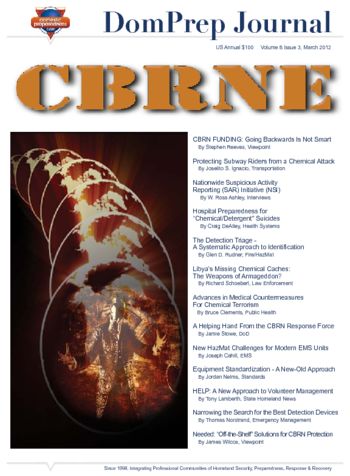

Protecting Subway Riders from a Chemical Attack
Joselito S. Ignacio
March 28, 2012
The numbers are staggering – U.S. subway systems carry literally billions of passengers every year, while all of the nation’s airlines combined carry less than one billion! Today, airline passenger screening is routine, and reasonably thorough. However, there is little if any screening of subway passengers, making subways an easier target for a possible terrorist attack.

A Helping Hand from the Defense CBRN Response Force
Jamie Stowe
March 28, 2012
The recent upgrading of the Defense Department’s former CBRN Consequence Management Response Force
means that states, cities, and smaller communities throughout the country will have much greater medical
response capabilities – personnel as well as equipment – than was ever before possible.

CBRN FUNDING: Going Backwards Is Not Smart
Stephen Reeves
March 28, 2012
The huge budget problems now facing the nation are on a collision course with the rapidly
escalating possibility of new CBRN incidents and events that could devastate entire communities. A
distinguished former Department of Defense program official puts the dilemma into context and provides
several useful guidelines to follow.

Libya’s Missing Chemical Caches: The Weapons of Armageddon?
Richard Schoeberl
March 27, 2012
There are several “known” unknowns – namely, how to develop, produce, and deploy chemical and biological weapons that are more toxic than ever before possible. There also are some “unknown” unknowns, the most important of which is this: Where are the tons of chemical weapons that disappeared from Libya’s reported and unreported stockpiles?

Nationwide Suspicious Activity Reporting (SAR) Initiative (NSI) Roundtable
W. Ross Ashley
March 27, 2012
In the 21st century, combatting terrorism could be as simple as seeing something and saying
something. Suspicious activity may signify terrorist activity, but that can only be determined if the
right information gets into the right hands. Listen to W. Ross Ashley’s audio roundtable discussion on
the Nationwide Suspicious Activity Reporting Initiative (NSI), which presents a key business process for
protecting the nation against future terrorist threats.

The Detection Triage – A Systematic Approach to Identification
Glen Rudner
March 21, 2012
Success in any field of human endeavor usually requires not only education and training but also having at hand the best “tools” available to do the job – no matter what that job entails. In hazmat or CBRNE incidents, the tools used by emergency responders include a broad array of detection, analysis, and identification devices, an uncommon degree of common sense, and a healthy awareness of the many dangers and possible pitfalls usually involved.

Narrowing the Search for the Best Detection Devices
Thomas Norstrand
March 21, 2012
Even the best trained and most highly motivated responders can be no better than their equipment. This means that the search for and purchase of the best equipment available must always be a top priority for senior management with critical decision-making responsibilities.

Equipment Standardization – A New-Old Approach
Jordan Nelms
March 21, 2012
The so-called “standardization” of equipment is intended to lower costs, simplify procurement decisions, and also improve training and operational capabilities – theoretically, at least. When the standards previously approved are not followed, though, or are simply ignored, new and complex difficulties follow in short order. When those difficulties complicate CBRNE operations, the results could be almost cosmic in nature.

New HazMat Challenges for Modern EMS Units
Joseph Cahill
March 14, 2012
In today’s increasingly complex and ever more dangerous world, EMS units in U.S. communities both large and small are learning to cope with a broad spectrum of mass-casualty incidents and events never before encountered by their predecessors. Here are a few common-sense cost, training, political, legal,
and operational suggestions that should help.

HELP: A New Approach to Volunteer Management
Tony Lamberth
March 14, 2012
From the Pre-Colonial Era to the present, America has been a nation of volunteers. The tradition of neighbors helping neighbors is probably more important today, though, than ever before. The cost of dealing with a “relatively minor” CBRNE incident is prohibitively expensive, and it is likely to be years before, if ever, current budgetary restrictions can be eased even slightly.

